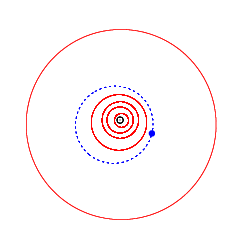9938 Kretlow
|
| |||||||||||||
| Discovery | |||||||||||||
|---|---|---|---|---|---|---|---|---|---|---|---|---|---|
| Discovered by | W. Landgraf | ||||||||||||
| Discovery date | 18 May 1988 | ||||||||||||
| Designations | |||||||||||||
| MPC designation | 9938 Kretlow | ||||||||||||
| 1988 KA, 1982 VE2, 1985 QL | |||||||||||||
| Orbital characteristics[1] | |||||||||||||
| Epoch 13 January 2016 (JD 2457400.5) | |||||||||||||
| Uncertainty parameter 0 | |||||||||||||
| Observation arc | 12172 days (33.33 yr) | ||||||||||||
| Aphelion | 2.5454872 AU (380.79947 Gm) | ||||||||||||
| Perihelion | 1.7344121 AU (259.46436 Gm) | ||||||||||||
| 2.1399496 AU (320.13190 Gm) | |||||||||||||
| Eccentricity | 0.1895080 | ||||||||||||
| 3.13 yr (1143.4 d) | |||||||||||||
| 277.78349° | |||||||||||||
| 0° 18m 53.447s / day | |||||||||||||
| Inclination | 3.801314° | ||||||||||||
| 86.091439° | |||||||||||||
| 223.01332° | |||||||||||||
| Earth MOID | 0.720184 AU (107.7380 Gm) | ||||||||||||
| Jupiter MOID | 2.6947 AU (403.12 Gm) | ||||||||||||
| Jupiter Tisserand parameter | 3.688 | ||||||||||||
| Physical characteristics | |||||||||||||
| Dimensions | ~13.5 km[2] | ||||||||||||
| ~0.01 | |||||||||||||
| |||||||||||||
| 14.4 | |||||||||||||
|
| |||||||||||||
9938 Kretlow is a main belt asteroid. It orbits the Sun once every 3.13 years.[1]
Discovered on May 18, 1988 by W. Landgraf at the European Southern Observatory, it was given the provisional designation "1988 KA". It was later named "Kretlow" after Mike Kretlow, a student at the University of Siegen who studied comets and a longtime friend of the discoverer of 9938 Kretlow.[3]
References
- 1 2 "9938 Kretlow (1988 KA)". JPL Small-Body Database. NASA/Jet Propulsion Laboratory. Retrieved 13 April 2016.
- ↑ Tedesco E.F.; Noah P.V.; Noah M.; Price S.D. "The supplemental IRAS minor planet survey (SIMPS)".
- ↑ MPC 42359 Minor Planet Center
External links
This article is issued from Wikipedia - version of the 9/10/2016. The text is available under the Creative Commons Attribution/Share Alike but additional terms may apply for the media files.
